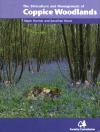Summary
 Background
Background
Coppice was the traditional form of silviculture practised in many woodlands in lowland Britain, and the estimated areas of simple coppice, and coppice with standards, has been declining for at least a century. However, during recent years there has been a revival of interest in this form of management.
Coppice woodlands often have a potentially high conservation value, but many of those that remain are neglected, and require management in order to retain their character and biodiversity. Whilst there has been much interest in the ecology of coppice woodlands there has been little systematic study of the silviculture of either coppice stools or woodlands.
Estimated areas (1000’s Ha) of simple coppice and coppice with standards recorded in surveys made during the 20th century
| Year | England | Wales | Scotland | Britain | Total | ||||
|---|---|---|---|---|---|---|---|---|---|
| C | S | C | S | C | S | C | S | ||
| 1905 | 215 | 6 | 9 | 230 | |||||
| 1913 | 208 | 8 | 11 | 227 | |||||
| 1924 | 31 | 163 | 7 | 8 | 2 | 2 | 40 | 173 | 213 |
| 1947 | 41 | 91 | 7 | 1 | < 1 | < 1 | 48 | 92 | 140 |
| 1965 | 18 | 10 | < 1 | X | X | X | 18 | 10 | 29 |
| 1980 | 26 | 11 | 2 | < 1 | < 1 | < 1 | 28 | 12 | 40 |
| 1997 | 11 | 10 | < 1 | X | < 1 | < 1 | 12 | 11 | 23 |
Notes on table:
C = Simple coppice;
S = Coppice with Standards;
X = none recorded in this survey.
Figures are thousands of hectares.
In 1905 and 1913 coppice types were not differentiated.
Adapted from “The Silviculture And Management Of Coppice Woodlands” (see below).
Experimental work
- A survey of recently felled coppice woodlands was carried out to gather information on current practices
- Restoration of neglected hazel coppice
- Growth of hazel coppice with standards
- Effects of time of felling and height of cutting coppice.
Experimental results are available in several publications.
 In addition a handbook has been published to give information and advice on the management of trees, stools and woodlands as coppice:
In addition a handbook has been published to give information and advice on the management of trees, stools and woodlands as coppice:
The silviculture and management of coppice woodlands.
Publications about coppice woodlands
Harmer, R. (2004). Restoration of neglected hazel coppice. Forestry Commission Information Note 56
Harmer, R. (2004). Coppice silviculture practiced in temperate regions. In: Encyclopedia of Forest Sciences Volume 3 (Ed J. Burley, J. Evans and J. Youngquist), Elsevier 1045-1052.
Harmer, R., and Howe, J. (2003). The silviculture and management of coppice woodlands. Forestry Commission, Edinburgh.
Harmer, R., and Robertson, M. (2002). Management of Standards in Hazel Coppice, Quarterly Journal of Forestry, 96, 259-265.
Harmer, R. (2001). Growth of coppice shoots following felling of maiden oaks at different heights above ground. Quarterly Journal of Forestry 95, 217-233.
Harmer, R., Robertson, M., Boswell, R. and Peace, A. (2001). Regrowth and browsing of coppice in southern England. Quarterly Journal of Forestry 95, 209-216.
Harmer, R. (1995). Management of coppice stools. Information Note 259 (PDF-881K). Forestry Commission, Edinburgh.
What’s of interest
For Forestry Commission publications:
On-line publications catalogue
